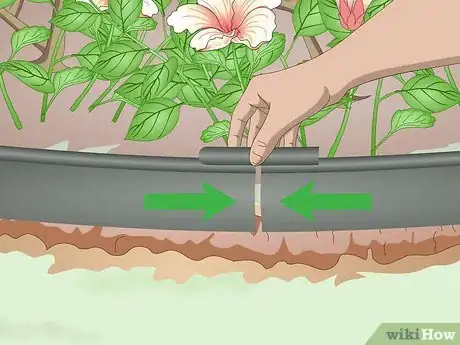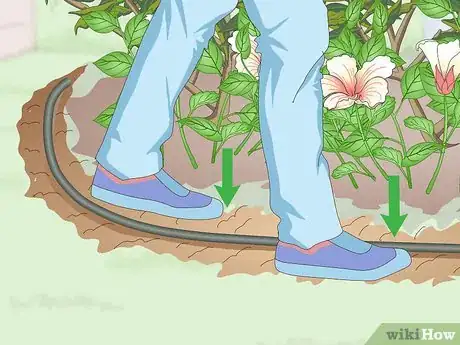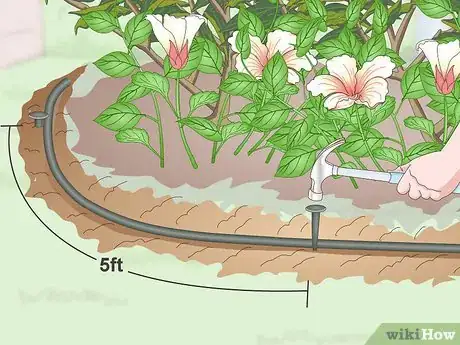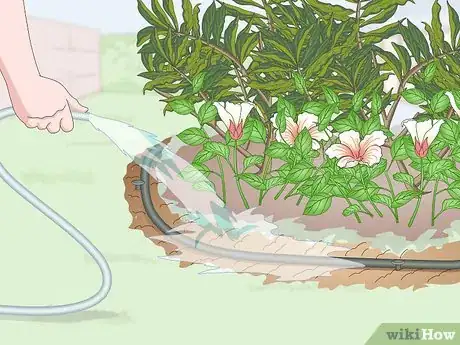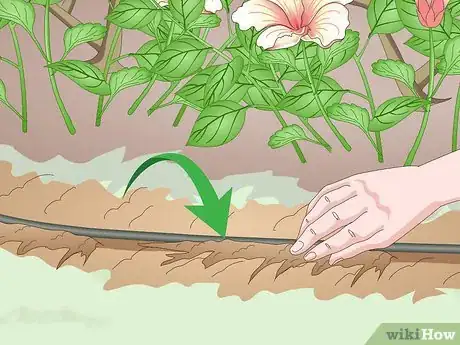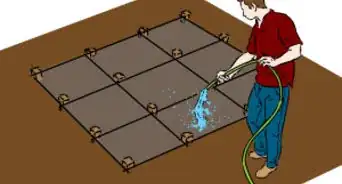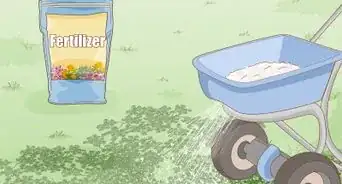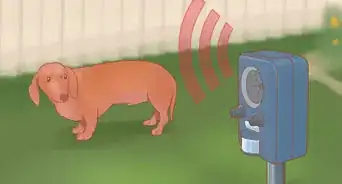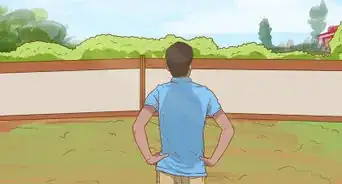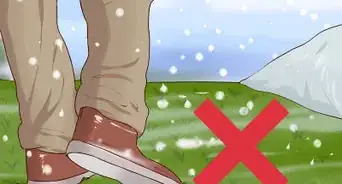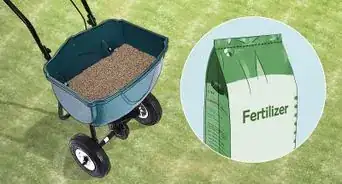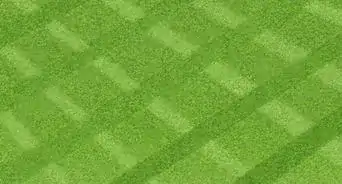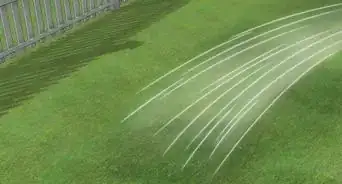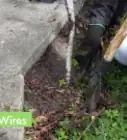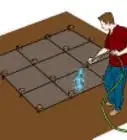This article was co-authored by Tony Hoang. Tony Hoang is a Landscaper and the Principal at H&J Landscaping & Concrete Contractor in Newark, CA. With over six years of experience, he specializes in designing the perfect concrete driveways & backyard patios for homes. H&J Landscaping & Concrete Contractor is a 4.5-star business on Yelp.
There are 8 references cited in this article, which can be found at the bottom of the page.
wikiHow marks an article as reader-approved once it receives enough positive feedback. In this case, 100% of readers who voted found the article helpful, earning it our reader-approved status.
This article has been viewed 362,376 times.
Plastic lawn edging is used to distinguish a garden bed from the rest of a lawn, making your garden look neat and tidy! To place the lawn edging, dig a trench around the garden bed and cut away any roots. Then set the edging by filling the trench in with soil again, and installing edging stakes.
Steps
Fitting Edging around a Garden Bed
-
1Measure the outline of the garden bed using rope. Lay out a piece of rope around the garden bed where you plan to install the edging. Then, measure the rope with a tape measure to determine how much edging you'll need.[1]
- You can purchase plastic edging from most gardening centers and home improvement stores.[2]
- Besides giving a neat look to the lawn, it acts as a barrier and prevents grass from growing in unwanted areas.[3]
- Plastic lawn edging is commonly sold in 20 ft (6.1 m) lengths.[4]
- The height of plastic lawn edging varies across brands. It typically ranges from 3–6 in (7.6–15.2 cm) high. Generally, 3 in (7.6 cm) edging is inexpensive and widely available, yet short enough for the grass rhizomes to easily grow into the garden bed, while 6 in (15 cm) is more expensive and difficult to find, yet will make garden bed maintenance easier in the long run.[5]
-
2Unroll the plastic lawn edging the day before you want to use it. Remove any plastic coverings or packaging. Lay the plastic lawn edging flat on the ground.[6]
Tip: If possible, leave the plastic edging in the sun over the next day. The sun will warm the plastic and make it less curled, and therefore easier to shape and use.
Advertisement -
3Dig a 3–6 in (7.6–15.2 cm) deep trench around the garden bed. Use a shovel to dig a neat trench around the whole bed where the plastic edging will go. Dig to the depth of the leading you plan to use. Keep the soil that you have dug up close by, as you'll be using it again soon.[7]
- The width of the trench must be slightly larger than the width of the edging. Although it depends on the width of your particular edging, approximately 2 in (5.1 cm) is normally sufficient.[8]
- You can use a rototiller rather than a shovel if you prefer.[9]
- Make sure you dig the trench deep enough so the plastic edging doesn't stick up out of the ground. If the edging sticks up too much, you could hit it with your lawn mower and cause damage.[10]
-
4Cut off any small roots that are in the way of the trench. Use pruning shears to remove any plant roots that are interrupting the 3–6 in (7.6–15.2 cm) deep trench. Leave any large, tree roots that are in the way, however, as it will be easier to cut the edging to accommodate these.[11]
- Once you have cut away the small roots, remove them from around the trench so that you have a clear space to work.
-
5Place the plastic edging into the trench. Push the edging firmly into the trench and against the garden bed.[12] Make sure that the top, decorative edge is just at the surface level of the trench.[13]
Note: Place the edging into the trench so that the lip on the bottom points toward the garden bed rather than the lawn.[14]
-
6Cut a notch in the plastic edging if there is a large tree root. Use scissors or a utility knife to cut a gap in the edging if there is a large root. Line it up with the root to check that you have the right spot.[15]
- Avoid placing edging around garden beds where there are many large tree roots, as you don’t want to cut away at the edging too much.
-
7Use a connector if the trench is longer than 1 roll of plastic edging. Slide the connector onto the end of each roll, so that the ends meet in the middle. Firmly push the connector down onto each end so that it feels sturdy and attached.[16]
- With an 8 in (20 cm) long connecter, 4 in (10 cm) from each end of edging will be used.
- The plastic lawn edging kit will come with connector pieces that you can use to connect 1 roll to another.
Filling and Setting Edging
-
1Fill the soil back into the trench. Use a shovel to place the soil that you previously dug up back into the trench. Fill the soil to the height where only the top ½ or ⅓ of the decorative, circular, edge is visible.[17]
- The top border of the lawn edging can stick out approximately half to three-quarters of an inch.[18]
- The inexpensive lawn edging is sold at 3 inches in height.[19]
- But it is better to use at least 4 inches and up to 6 inches to prevent grass from growing underneath and past your lawn edge.[20]
- Make sure that the soil is tightly packed.
- The edging will be the right height so that a lawnmower won’t get caught on it.
-
2Stomp along the curves of the edging with your feet. Flatten the soil to make it compact. This will push the edging outwards along the curve.[21]
-
3Install a stake at every 5 feet (1.5 m) along the edging. Place the stake into the soil so that it is right next to the top of the edging, and the pointed tip is going towards the "V" shape at the bottom. Hammer the part of the stake that is above the soil, to make the pointed tip go through the edging.[22]
- Stakes for plastic lawn edging are either straight or perpendicular in shape. These are installed in the same way.
Note: Stakes help to sturdy the garden bed and edging as the soil moves over time. This way, the edging cannot move any further away from the bed, and the soil will tightly compact it in the trench.
-
4Water the edging to settle the soil. Walk along your newly installed edging with a garden hose. Water the soil on both sides of the edging lightly.[23]
- You don’t need to saturate or flood the soil, as just enough water to make it moderately damp will do.
-
5Backfill the edging into any gaps in the soil. Use your hands to push soil into any small gaps that you may have missed between the garden bed and the lawn. Check to see that the edging feels sturdy in all places, and add more soil to any areas that require more support.[24]
Expert Q&A
-
QuestionWhat is the best lawn edging?
 Jeremy YamaguchiJeremy Yamaguchi is a Lawn Care Specialist and the Founder/CEO of Lawn Love, a digital marketplace for lawn care and gardening services. Jeremy provides instant satellite quotes and can coordinate service from a smartphone or web browser. The company has raised funding from notable investors like Y Combinator, Joe Montana, Alexis Ohanian, Barbara Corcoran and others.
Jeremy YamaguchiJeremy Yamaguchi is a Lawn Care Specialist and the Founder/CEO of Lawn Love, a digital marketplace for lawn care and gardening services. Jeremy provides instant satellite quotes and can coordinate service from a smartphone or web browser. The company has raised funding from notable investors like Y Combinator, Joe Montana, Alexis Ohanian, Barbara Corcoran and others.
Lawn Care Specialist Commercial-grade edging will be more durable and last longer than cheap plastic edging.
Commercial-grade edging will be more durable and last longer than cheap plastic edging. -
QuestionCan I use plastic edging to form a rectangular flower bed?
 Community AnswerYes you can. You can make ground stakes to put into each corner out of any scrap wood you have handy. You can paint the wood first to match the edging if you'd like. Pound your wooden stakes (maybe you chose 2x2s) into the ground and then cut your edging sides one at a time stopping after every cut to glue that end to your wood corner blocks. Ask at your home improvement store for help selecting an appropriate plastic-to-wood glue suitable for the type of plastic edging. (PVC notably requires specific adhesive) Measure twice and cut once with your edging to ensure sharp looking corners as they come together at the corner block.
Community AnswerYes you can. You can make ground stakes to put into each corner out of any scrap wood you have handy. You can paint the wood first to match the edging if you'd like. Pound your wooden stakes (maybe you chose 2x2s) into the ground and then cut your edging sides one at a time stopping after every cut to glue that end to your wood corner blocks. Ask at your home improvement store for help selecting an appropriate plastic-to-wood glue suitable for the type of plastic edging. (PVC notably requires specific adhesive) Measure twice and cut once with your edging to ensure sharp looking corners as they come together at the corner block. -
QuestionShould I cut the edging to get over tree roots?
 Community AnswerYes, you should, since your alternative is to cut the tree roots and you rarely want to do that. In some cases, it makes more sense to skip the tree root altogether if the root is above ground. If it's just underneath the ground, you can cut the underside of the edging, leaving the top intact.
Community AnswerYes, you should, since your alternative is to cut the tree roots and you rarely want to do that. In some cases, it makes more sense to skip the tree root altogether if the root is above ground. If it's just underneath the ground, you can cut the underside of the edging, leaving the top intact.
Warnings
- Make sure that you are wearing gardening gloves when handling soil. Soil is a common source of bacteria, which can cause infections.[25]⧼thumbs_response⧽
References
- ↑ https://www.thisoldhouse.com/how-to/how-to-edge-garden-bed-brick
- ↑ Keith Souza. Home Improvement Specialist. Expert Interview. 20 August 2021.
- ↑ Keith Souza. Home Improvement Specialist. Expert Interview. 20 August 2021.
- ↑ http://renegadegardener.com/dont-do-that-archive/dont-install-plastic-landscape-edging-improperly/
- ↑ https://laidbackgardener.blog/2015/08/25/lawn-edging-time-saving-when-you-install-it-correctly/
- ↑ https://www.prettyhandygirl.com/how-to-install-landscape-bed-black-edging/
- ↑ https://www.prettyhandygirl.com/how-to-install-landscape-bed-black-edging/
- ↑ https://laidbackgardener.blog/2015/08/25/lawn-edging-time-saving-when-you-install-it-correctly/
- ↑ http://renegadegardener.com/dont-do-that-archive/dont-install-plastic-landscape-edging-improperly/
- ↑ Jeremy Yamaguchi. Lawn Care Specialist. Expert Interview. 21 January 2020.
- ↑ http://renegadegardener.com/dont-do-that-archive/dont-install-plastic-landscape-edging-improperly/
- ↑ Keith Souza. Home Improvement Specialist. Expert Interview. 20 August 2021.
- ↑ https://www.prettyhandygirl.com/how-to-install-landscape-bed-black-edging/
- ↑ http://renegadegardener.com/dont-do-that-archive/dont-install-plastic-landscape-edging-improperly/
- ↑ https://www.prettyhandygirl.com/how-to-install-landscape-bed-black-edging/
- ↑ http://renegadegardener.com/dont-do-that-archive/dont-install-plastic-landscape-edging-improperly/
- ↑ http://renegadegardener.com/dont-do-that-archive/dont-install-plastic-landscape-edging-improperly/
- ↑ Tony Hoang. Landscaping Manager. Expert Interview. 12 December 2022.
- ↑ Tony Hoang. Landscaping Manager. Expert Interview. 12 December 2022.
- ↑ Tony Hoang. Landscaping Manager. Expert Interview. 12 December 2022.
- ↑ http://renegadegardener.com/dont-do-that-archive/dont-install-plastic-landscape-edging-improperly/
- ↑ http://renegadegardener.com/dont-do-that-archive/dont-install-plastic-landscape-edging-improperly/
- ↑ http://renegadegardener.com/dont-do-that-archive/dont-install-plastic-landscape-edging-improperly/
- ↑ http://renegadegardener.com/dont-do-that-archive/dont-install-plastic-landscape-edging-improperly/
- ↑ https://theconversation.com/at-least-five-reasons-you-should-wear-gardening-gloves-89451
About This Article
To install plastic lawn edging, start by measuring the perimeter of your garden bed using rope to determine how much edging you'll need. Then, dig a 3-6 inch deep trench around your garden bed that's slightly wider than the width of the edging. Next, place the plastic edging in the trench so the lip on the bottom is pointing toward your garden bed and not the lawn. If you need multiple rolls of edging, use a connector to attach the ends of the rolls. Finally, fill the trench in with soil and install a stake every 5 feet along the edging. To learn how to deal with tree roots that get in the way, scroll down!








